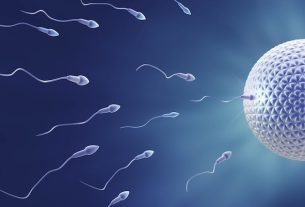In the 29th week of pregnancy, the baby’s development is marked by beginning to better control the rhythm of breathing and body temperature due to the development of the brain, which better controls these functions.
The baby’s skin is now less wrinkled due to the accumulation of fat on the skin and the bones are becoming increasingly rigid.
During this week, the woman may continue to have symptoms of leg cramps, or Braxton-Hicks contractions, and excessive tiredness and enlargement of the feet may appear, which may become wider and longer.

Baby development
In the 29th week of pregnancy, the main developmental milestones are:
- The baby’s organs and senses continue to develop and new cells multiply all the time;
- The head is growing and the brain is very active, gaining this week the function of controlling the rhythm of breathing and body temperature;
- The baby’s skin begins to become thicker and less wrinkled, with a redder color;
- The bones become increasingly rigid, consuming more calcium from the woman’s diet.
In this week of pregnancy, if the baby is a boy, the testicles descend from near the kidneys to the groin, towards the scrotum.
In the case of girls, the clitoris is a little more prominent, because it has not yet been covered by the vaginal lips, which will only happen completely in the last few weeks before birth.
Baby size and weight
The size of the baby at 29 weeks of gestation is about 37 centimeters measured from head to toe and about 26.4 centimeters from head to bottom, being equivalent to the size of a green pumpkin.
The baby’s weight this week is around 1.25 kg.
Changes in a woman’s body
In the 29th week of pregnancy, due to the pressure of the uterus on the intestine and decreased bowel movements, the woman may experience constipation. Additionally, symptoms of Braxton Hicks contraction, leg cramps, or heartburn may continue.
At this stage of pregnancy, it is also common for women to experience excessive tiredness, and due to normal hormonal changes during pregnancy, feet can become wider and longer, making it recommended to wear larger shoes.
Care during the 29th week
In the 29th week of pregnancy, some precautions are important to help alleviate discomfort that may arise, such as:
- Constipation: One should keep the body hydrated by drinking at least 8 glasses of water a day and eat more fiber in the form of whole grains, fresh fruits and vegetables. Practicing physical exercises regularly recommended by your doctor can also help improve intestinal transit and alleviate this discomfort;
- Asia: not lying down after meals and eating in small amounts at intervals of less than 2 to 3 hours can help alleviate this discomfort. Another important measure is to avoid drinking liquids during meals and avoid eating fried foods, spicy or highly seasoned foods. See other tips on how to relieve heartburn during pregnancy;
- Braxton-Hicks contractions: moving your body or doing physical exercises recommended by your doctor helps alleviate the discomfort of contractions. However, if the contraction is strong, very frequent or accompanied by other symptoms such as back pain, vaginal bleeding or liquid discharge, medical help should be sought immediately, as the woman may have gone into labor. Know how to identify the signs of labor;
- Leg cramps: Doing a little physical exercise, gently stretching the calf, massaging the calf, applying warm compresses, or using supplements such as calcium, magnesium or vitamin B recommended by your doctor, can help reduce cramps. Furthermore, it is important to keep the body hydrated, drinking at least 8 glasses of water a day, to help improve blood circulation in the legs and avoid cramps;
- Excessive tiredness: resting during the day, if possible, going to bed a little earlier at night, can help reduce tiredness and increase mood.
It is important to maintain a balanced diet including fresh fruits and vegetables and eat small portions, but frequently to ensure that nutrients reach the baby, drink at least 8 glasses of water a day, practice physical activities recommended by your doctor and always rest. as possible. Check out what your diet should be like during pregnancy.
Furthermore, it is recommended to increase the consumption of foods rich in calcium such as milk, cheese, spinach, sardines and broccoli, which is essential for strengthening the baby’s bones. See the complete list of foods rich in calcium.
Throughout your pregnancy, it is important to continue taking the vitamins and supplements recommended by your doctor and avoid taking medications on your own.
Confirm which month of pregnancy you are entering your details here:
Bibliography
- AMERICAN PREGNANCY ASSOCIATION. 29 Weeks Pregnant. 2024. Disponível em: <https://americanpregnancy.org/healthy-pregnancy/week-by-week/29-weeks-pregnant/>. Acesso em 24 jan 2024
- KISERUD, T.; et al. The World Health Organization Fetal Growth Charts: A multinational longitudinal study of ultrasound biometric measurements and estimated fetal weight. PLoS Med. 14. 3; e1002284, 2017
- STATPEARLS (INTERNET). TREASURE ISLAND (FL): STATPEARLS PUBLISHING. Braxton Hicks Contractions. Available at: <https://pubmed.ncbi.nlm.nih.gov/29262073/>. Accessed on June 14, 2021
- ZHOU, Kunyan; et al. Interventions for leg cramps in pregnancy. Cochrane Database Syst Rev. 8. CD010655, 2015
- SEGAL, NA; et al. Pregnancy leads to lasting changes in foot structure. Am J Phys Med Rehabil. 92. 3; 232-40, 2013
- IMDAD, A.; et al. Role of calcium supplementation during pregnancy in reducing risk of developing gestational hypertensive disorders: A meta-analysis of studies from developing countries. BMC Public Health. 3. 3; S18, 2011
- KISERUD, T.; et al. The World Health Organization Fetal Growth Charts: A multinational longitudinal study of ultrasound biometric measurements and estimated fetal weight. PLoS Med. 14. 3; e1002284, 2017
- STAINED GLASS, GLN; et al. Skin thickness as a potential marker of gestational age at birth despite different fetal growth profiles: A feasibility study. PLoS One. 13. 4; 2018
- KUMAR, A.; KAUR, S. Calcium: A nutrient in pregnancy. J Obstet Gynaecol India. 67. 5; 313-318, 2017

Sign up for our newsletter and stay up to date with exclusive news
that can transform your routine!
Warning: Undefined array key "title" in /home/storelat/public_html/wp-content/plugins/link-whisper-premium/templates/frontend/related-posts.php on line 12
Warning: Undefined array key "title_tag" in /home/storelat/public_html/wp-content/plugins/link-whisper-premium/templates/frontend/related-posts.php on line 13




